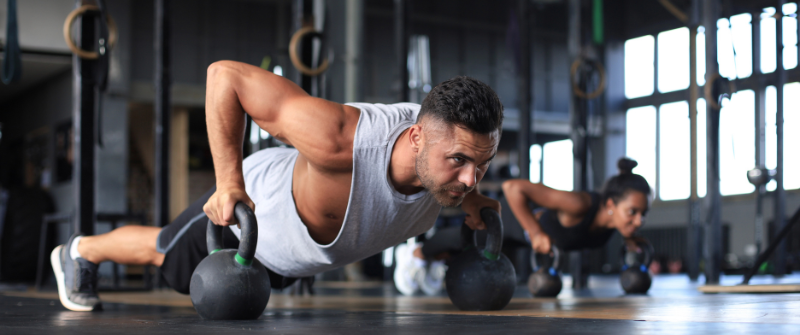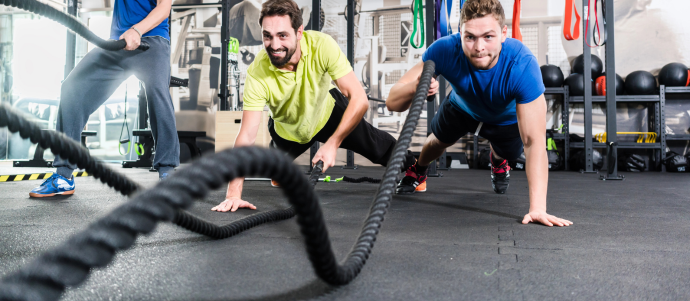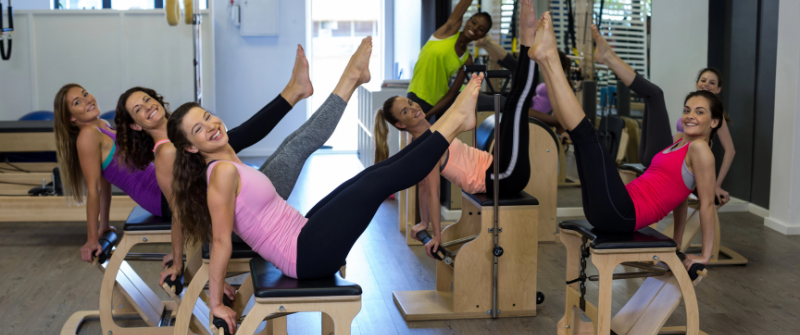
- by NEXO Team
- August 30, 2024
Functional fitness is an approach to exercise that looks similar to movements you make in your day-to-day life, which sets it apart from traditional gym routines. Although the concept itself may seem simple, practicing functional fitness actually helps people enhance their overall health, boost performance in their activities, and build stronger, more resilient bodies. In this article, we’ll outline the key benefits of functional fitness training and provide strategies for integrating it into a daily fitness routine.
Benefits of Functional Fitness
Improved Daily Life Activities
Functional fitness training enhances a person’s ability to perform their everyday tasks with more ease and efficiency. By focusing on movements that mirror real-time actions, practicing functional fitness improves mobility, flexibility, balance, and coordination. This leads to a reduced risk of falls and injuries, which makes daily physical activities more manageable.
Increased Strength and Endurance
Functional fitness consists of full-body workouts that engage multiple muscle groups at the same time. It helps improve overall strength and stamina improvement, particularly when it comes to building core stability. Having a strong core is key for overall health and performance, which benefits both daily activities and other forms of exercise.
Injury Prevention
By practicing movements that mimic everyday activities, functional fitness training preps the body for common daily tasks, which significantly reduces the risk of day-to-day injuries. Functional fitness also supports joint health through proper movement patterns and reducing stress on the joints to support long-term physical well-being.
Enhanced Mental Health
While many of the benefits of functional fitness training are physical, it also helps people develop a stronger mind-body connection which leads to better mental clarity and stress reduction. Mastering functional movements also increases self-confidence and motivation, making it easier to maintain a regular fitness routine and continue working towards health goals.
Essential Strategies for Incorporating Functional Fitness
Start with Basic Movements
Functional fitness training begins with mastering basic movements like squats, lunges, and planks. As strength and confidence begins to build through doing these exercises, it’s recommended to gradually increase the intensity and complexity of the movements. Taking a progressive approach helps you stay safe as you advance your functional fitness abilities and begin to tackle more challenging moves.
Incorporate Functional Fitness into Daily Life
Integrating functional fitness training into a daily routine is easier than you might think. Practice squats while picking up items from the floor, or try balancing on one leg while brushing your teeth. These simple strategies turn everyday activities into an opportunity to practice functional fitness training. Additionally, bodyweight exercises like pushups and burpees can be done virtually anywhere without the need for equipment, so you can keep your functional fitness training consistent and convenient.
Personalize Your Functional Fitness Routine
Tailor your functional fitness training to address specific goals, like improving posture, increasing mobility, or enhancing sports performance. When you align your routine with your lifestyle and long-term health goals, you’re more motivated to work towards meaningful improvements in your day-to-day life.
Utilize Functional Fitness Equipment
Functional fitness training is easily enhanced with simple tools like resistance bands, medicine balls, and kettlebells. These pieces make your workout more challenging while also adding a bit of variety to keep your routine interesting. To help you maintain your workout regimen even when you can’t make it to a fitness center, set up a basic home gym for functional fitness training. All that’s needed is a little bit of extra space and some of the equipment outlined above.
Seek Professional Guidance
To maximize all of the benefits that functional fitness training has to offer, consider working with a fitness professional. Functional fitness trainers help clients develop tailored program designs, while also supporting them with proper form and technique. If you’re looking for motivation, variety, and expert instruction in a group setting, you may also want to join a functional fitness class. Both options are helpful when it comes to enhancing functional fitness training and seeing results.
Integrating Functional Fitness with Other Fitness Modalities
Combining Functional Fitness with Cardiovascular Exercise
Functional fitness training seamlessly integrates with cardiovascular exercises to help people boost their overall health. For example, combining High-Intensity Interval Training (HIIT) workouts like burpees or mountain climbers with functional fitness training creates a powerful full body workout that improves both strength and endurance. This maximizes the many benefits of functional fitness training while simultaneously supporting the cardiovascular system.
Functional Fitness and Strength Training
To create a well-rounded workout routine, try balancing functional fitness training with traditional strength exercises. Functional fitness training enhances weightlifting practices by improving movement patterns and reducing the risk of injury. This combined approach also helps with comprehensive muscle development while maintaining all the practical benefits of functional movements. Alternate days between functional fitness and traditional strength training, or combine them in a single session by starting with compound functional movements and finishing with isolation exercises.
Functional Fitness and Flexibility
Another great way to complement functional fitness training is with yoga or Pilates, as these workouts improve flexibility, balance, and overall body awareness. Regular stretching and mobility work are also key components of a comprehensive functional fitness training program, as these practices help prevent injuries and improve overall performance. By incorporating exercises that promote flexibility, you take a more holistic approach to functional fitness training.
Tracking Progress and Staying Motivated
Setting Realistic Goals
Establish both short- and long-term goals to keep your journey with functional fitness on track. Make sure the goals that you set for yourself are SMART: Specific, Measurable, Achievable, Relevant, and Time-bound. It may also be helpful to use functional fitness assessments, such as movement screening and strength tests, to objectively measure your progress. These tools help you set achievable milestones while keeping you motivated in the process.
Creating a Workout Schedule
When it comes to functional fitness training, consistency is key. Develop a regular workout schedule that fits in well with your lifestyle to maintain your progress while building lasting habits. To avoid plateaus and prevent boredom, it’s important to mix up exercises and routines on a regular basis. You may want to try attending a new class or incorporating different equipment into your routine, as this will help you get more out of your workout by making it challenging and engaging.
Tracking Results
Use fitness journals or apps to record workouts, track progress, and jot down any milestones. Doing this offers valuable insight into your fitness journey while also helping you stay accountable. Remember that choosing to improve your health with a new workout routine is a huge accomplishment in itself, so it’s important to celebrate your achievements, no matter how small they may seem. Acknowledging your progress boosts motivation and reinforces your commitment to functional fitness, which keeps you inspired to continue on your path to better health.
Conclusion
From improving daily activities and preventing injuries to supporting mental wellbeing, functional fitness has several health benefits. By incorporating the strategies outlined above into your daily routine, you’ll build a stronger, more resilient body. Start your own functional fitness journey today by talking to a fitness professional, joining a local class, or trying basic exercises at home.
For gym owners, remember that protecting your business is just as important as maintaining your fitness. Consider partnering with NEXO, a trusted provider with over 15 years of experience in tailored fitness facility coverage, so you can focus on running your gym and helping others achieve their functional fitness goals. Get in touch with us today to learn more.
Categories
Fill out a short form to contact us with your questions or to receive a customized quote.
Recent Posts
-
 Why Jiu-Jitsu Schools Face Higher Liability Than Other Gyms and How to Manage It
January 5, 2026
Why Jiu-Jitsu Schools Face Higher Liability Than Other Gyms and How to Manage It
January 5, 2026 -
 Is Your Pilates Studio Prepared for a Medical Emergency?
January 5, 2026
Is Your Pilates Studio Prepared for a Medical Emergency?
January 5, 2026 -
 NEXO’s Affinity Program: How Fitness Suppliers and Associations Can Partner for Profit and Protection
December 5, 2025
NEXO’s Affinity Program: How Fitness Suppliers and Associations Can Partner for Profit and Protection
December 5, 2025 -
%20(1).png) How to Insure an MMA Gym Without Paying for Coverage You Don’t Need
December 5, 2025
How to Insure an MMA Gym Without Paying for Coverage You Don’t Need
December 5, 2025 -
 Mastering Liability for Jiu-Jitsu Tournaments and Martial Arts Events
December 5, 2025
Mastering Liability for Jiu-Jitsu Tournaments and Martial Arts Events
December 5, 2025
